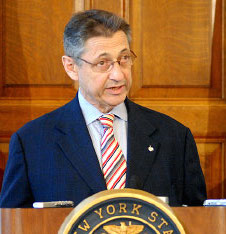
Back in 2005, a Suffolk County grand jury was convened to investigate waste, fraud and fiscal mismanagement in Suffolk’s public schools. Among its key findings was “an abject lack of transparency” regarding the area where school districts spend the vast bulk of their funds: salaries and benefits.
“Abject” the lack of transparency was — and is. But school districts are hardly unique in this. Long Island‘s county and municipal governments, like their counterparts across New York, also routinely hide from the public important details of employee compensation and tentative labor contracts.
Latest case in point: Suffolk County’s proposed contract with the Police Benevolent Association.
County Executive Steve Bellone first announced the deal on Aug. 2, yet it was only last Friday, five weeks later, that he got around to making public his memorandum of agreement with the union, whose members are the biggest locally funded cost center in a deficit-ridden county budget.
Why the delay? In a prepared statement, Bellone’s office said the memo and a financial impact statement “were released when everything had been reviewed by legal departments to ensure that all provisions in the [agreement] were characterized appropriately and accurately,” and that “edits” had been made “to accurately reflect negotiated terms.”
Huh? The original agreement was initialed on July 31 by Bellone’s acting director of labor relations, Paul J. Margiotta — who also happens to be chief deputy county attorney. It still needed a monthlong legal review? And if a financial impact analysis wasn’t done until last week, why did Bellone’s Aug. 2 news release claim the deal made “historic progress in saving hundreds of millions of taxpayer dollars”?
While the original tentative contract stretched to 2020, the final version guarantees current cops an average raise of 3 percent a year through 2018. It also includes one more late-breaking concession to the union: a provision letting the PBA reopen wage talks if inflation in any year tops 5 percent.
The cops also won a broad no-layoff guarantee and a “unit work” provision assuring them that no additional jobs assigned to PBA members will be shifted to less expensive employees. The cops will not only regain their coveted highway patrol slots from the county’s cheaper sheriff’s deputies — in the future, any helicopter pilots hired by the county must be PBA members.
As I first noted in a column last month, the proposed agreement also stipulates that the no-layoff pledge and unit work provision must be treated as “mandatory subjects” of negotiation in future. This would have the effect of giving the PBA virtually ironclad job security for generations to come.
Although the contract will add at least $200 million to the county’s costs by 2018, the executive can point to a two-and-a-half-year wage freeze, to a less expensive pay scale for new hires, and to the union’s agreement to require new officers to kick in a token 15 percent of their health insurance premiums. Bellone can argue that these gains, unlikely had the pact gone to arbitration, were worth the concessions he made to the PBA.
Even now, the information released by the county executive falls short of demonstrating conclusively that this is a good deal. But if he thinks he isn’t getting enough credit for the positives, he has only himself to blame. By withholding crucial details for more than a month, then trying to rush the pact to a vote in the county legislature, he has given the impression that he had something to hide.
Bellone should dig out that old grand jury report and take to heart its recommendations for improving government transparency. It’s never too late to let the sun shine in.







